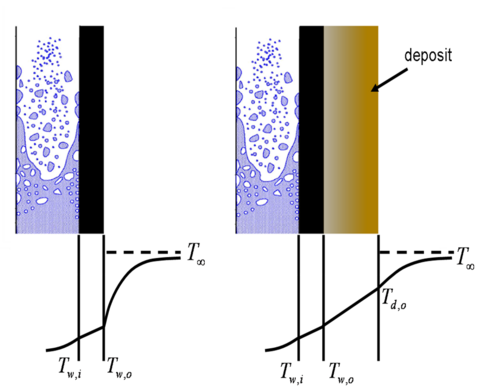Reduction of slagging tendencies
Project Objective
Slagging and fouling in steam generators have led to serious operational problems in power plants, especially with rising live steam parameters, as well as higher combustion temperatures. These problems are the result of ash particles adhering on heat exchanging surfaces. Extremely thick deposits can be formed through the accumulation of particles, which have an insulating effect on the heat transfer to the water steam cycle. This effect causes the surface temperature inside the boiler to rise, meaning the heat of the combustion can no longer be optimally carried out. This results in the temperature profile inside the boiler being forced further back, which worsens the efficiency of the entire plant, raises the material stresses on the individual heat exchangers, and ultimately reduces the operational life of the facility.
At the same time, the slagging tendency is influenced by a variety of factors. Next to the accumulation of ash, the temperature history also plays an important role in the characteristics and the adhesion of the ash particles. Numerous measuring and analysis methods were developed in the past to determine the behavior of ash.
Together with the EnBW and the IFK of the University of Stuttgart, this project looks to gain a deeper understanding of the reactions and mechanisms taking place in the formation of slag, through which the efficient working order, as well as the overall consumption of fuel, can be optimized. In the framework of the project, fundamental research on the formation of slag should be carried out. The innovative approach exists in the thorough characterization of the coal and its ashes, especially concerning their particle size distribution, in a wide range of test facilities.
Methods
Bituminous coal and lignites will be examined based on a detailed characterization of the fuel concerning their composition and combustion properties. In the selection of coal, its current relevance to the industrial partner will be taken into account. Next to the fuel analysis, selected fuels should be subject to combustion tests in test facilities of increasing size. At the institute, the entrained flow reactor will be used in the framework of the project. Modern measurement technologies for flue gas analysis, deposition rate measurement, and ash analysis methods for particle size distribution will be characterized and analyzed in the combustion process. The ash samples from the reactor will be examined concerning their varying composition.
The tests will involve CFD calculations, and a model for the simulation of particle size distribution dependent on time, temperature and location should be implemented. The model should be validated by the data from experimental testing. So far, the implementation of the viscosity as liable criterion has been considered state-of-the-art technology. In the framework of the project, a new approach should be explored, based on the role of the melting phase in the ash particles.
The initial layer should also be thoroughly examined; this layer is composed of the recondensation of mineral components of the coal, which evaporated during the combustion process. Simulations should then be carried out using FactSage, and the results then integrated into the CFD simulations.
The essential assignments of the Institute for Energy Systems in this project are:
- Construction of the fuel database and fuel analysis
- The running of tests in the entrained flow reactor
- Modeling of the thermodynamic equilibrium
- CFD modeling of the entrained flow reactor
For More Information
Contact the staff members responsible for the project: Dipl.-Ing. Christoph Wieland
KW21-Website: Link

